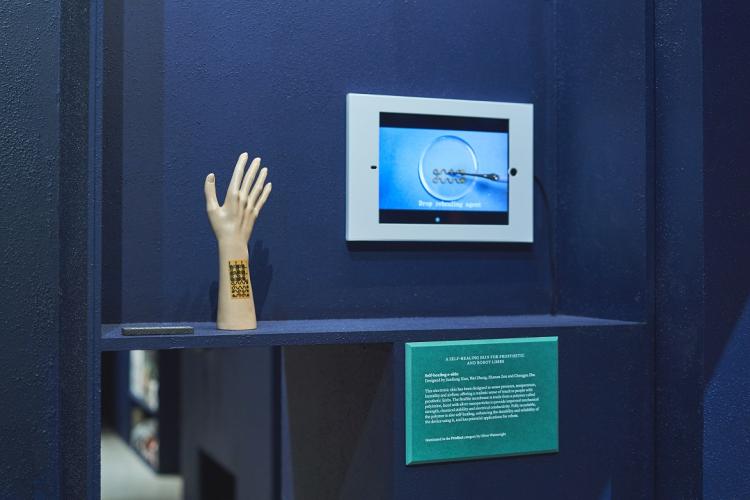Self-healing, fully-recyclable electronic skin has new applications
CU Boulder researchers developing advanced electronic skin are now investigating applications surrounding the material's ability to shapeshift.
This technology is being developed by CU Boulder Associate Professor Jianliang Xiao of the Department of Mechanical Engineering in collaboration with Professor Wei Zhang of the Department of Chemistry. Their completely recyclable, self-healing e-skin may one day lead to improvements in human health, robotics, prosthetics and beyond.

A patch of e-skin developed by Associate Professor Jianliang Xiao's research group.
Their technology was one of 80 designs from across the world displayed at the Beazley Designs of the Year exhibit in London and was displayed at Parsons School of Design in New York at the In:Bodied – The Augmented Self exhibition in March 2019.

E-skin developed by Xiao and his research group on display at the Beazley Designs of the Year exhibit in London. It was also featured at Parsons School of Design in New York at the In:Bodied – The Augmented Self exhibition.
Xiao’s recent focus has been on improving the e-skin’s mechanical performance.
“Previously, the device was flexible but not as stretchable as a rubber band,” Xiao said. “Now, we’re trying to make it so it can be stretched larger without breaking.”
When the material does break, self-healing technology allows for a quick and easy recovery. Because the material contains bonds that are constantly breaking and reforming, when broken parts of the material come into contact with one another, the bonds naturally rebuild. In the past, the group used heat and pressure to initiate this process, but now, it can heal at room temperature on its own, much like human skin.
The material becomes less sensitive the more it breaks, but when e-skin reaches the end of its life, it can be fully recycled for use in future generations of e-skin. When placed in organic solvents, the material breaks into particles and oligomers that are separated for use in newly fabricated e-skin.
“I think this work has huge potential in terms of protecting the environment,” Xiao said. “It improves lives, improves healthcare and at the same time, we have designed it to have no negative effect on the environment.”
Xiao said he hopes e-skin will one day be used in skin grafts and transplants. He also said a patch of e-skin could monitor a person’s vital signs and can increase the capabilities of someone who uses a prosthetic device. A person using a prosthetic hand, for instance, will have better dexterity and can more successfully carry a range of items when he or she is able to sense them. By stimulating the neural system with electrical signals, e-skin sends messages to the brain that portray what the skin is feeling. In robots, e-skin is being used to improve the way a robot interacts with human environments.
While studying the malleability and shape memory of the material, Xiao has begun developing an antenna that can transform from one shape to another. When exposed to a stimulus, the device transforms and when the stimulus is removed, the elasticity of the material leads it to morph back into its original shape.
Xiao said he has been able to accomplish more than he could have alone with a team whose backgrounds are varied.
“People with different training have different ways of thinking and different philosophies which make the work unique,” Xiao said. “The technology we’ve developed has wide application and can transform human life.”

